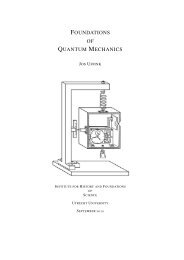Subjective probability and statistical physics
Subjective probability and statistical physics
Subjective probability and statistical physics
You also want an ePaper? Increase the reach of your titles
YUMPU automatically turns print PDFs into web optimized ePapers that Google loves.
they refer to a fictional construct, i.e. the ensemble. Time averages, on the other<br />
h<strong>and</strong>, are often notoriously hard to calculate but do refer to an objective property<br />
of a single system. If one can show that the time averages <strong>and</strong> ensemble averages<br />
coincide, one can, as it were, combine the best of both worlds, i.e. compute ensemble<br />
averages <strong>and</strong> equate them with objective properties of a single system.<br />
Therefore, the Birkhoff-von Neumann ergodic theorem, which specifies under<br />
which conditions this equality holds, <strong>and</strong> generalizations of this theorem in ergodic<br />
theory are often regarded as highly relevant in an objective approach. In this approach,<br />
then, the assumption of dynamical properties (such as metrical transitivity,<br />
mixing, etc.) that form the basis of the ergodic theorem becomes a major issue, <strong>and</strong><br />
their failure for realistic systems a serious problem in the theory. (cf. (Earman &<br />
Redei 1996, Uffink 2007).<br />
In contrast, adherents to the subjective view often take pride that their view has no<br />
such qualms. The motivation for adopting an ensemble, in this view, is not that it has<br />
any empirical relevance but rather that it adequately reflects our epistemic judgment<br />
about the system. Hence, the choice of a microcanonical <strong>probability</strong> measure need<br />
not be justified by reference to dynamical properties like metrical transitivity at all,<br />
<strong>and</strong> the ergodic problem can simply be ignored, or so it is claimed.<br />
However the issue is not that simple. For example, we have seen that Tolman<br />
motivated the choice of the microcanonical measure among other things by the idea<br />
that when we have no information about about the time at which the system has<br />
been prepared, we should adopt a <strong>probability</strong> measure that is stationary under timetranslations.<br />
This argument would take us to the microcanonical measure, if the<br />
microcanonical measure were the unique stationary measure on phase space. But<br />
this is only the case (amongst those measures that are absolutely continuous with<br />
respect to the Lebesgue measure) iff the system is metrically transitive. In other<br />
words, the results <strong>and</strong> problems of ergodic theory are relevant to subjectivist <strong>and</strong><br />
objectivist alike.<br />
Indeed, the subjective view on <strong>probability</strong> can positively contribute to ergodic<br />
theory as is shown by von Plato’s (1982) analysis of the ergodic decomposition theorem.<br />
This theorem says roughly that any stationary <strong>probability</strong> measure must be a<br />
convex mixture of ergodic <strong>probability</strong> measures. Von Plato showed that this can be<br />
seen as an analogy to De Finettti’s exchangeability theorem for arbitrary dynamical<br />
systems (See von Plato (1982) <strong>and</strong> van Lith (2001b) for details.)<br />
A more controversial issue in the question whether the subjective view may be<br />
superior to the objective view is Jaynes’ claim that his Maximum Entropy approach<br />
would yield an “almost unbelievably short” proof of the second law of thermodynamics.<br />
Roughly speaking, his argument is as follows. Suppose that at some time t 0<br />
a number of observables (O 1 , . . . O n ) are measured <strong>and</strong> their values are found to be<br />
(o 1 , . . . o n ). We describe the system by a <strong>probability</strong> density ρ obtained by maximzing<br />
the Gibbs entropy<br />
∫<br />
S G = − ρ(x) log ρ(x)dx, (17)<br />
Γ<br />
20
















